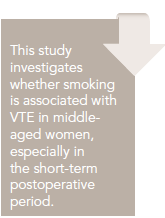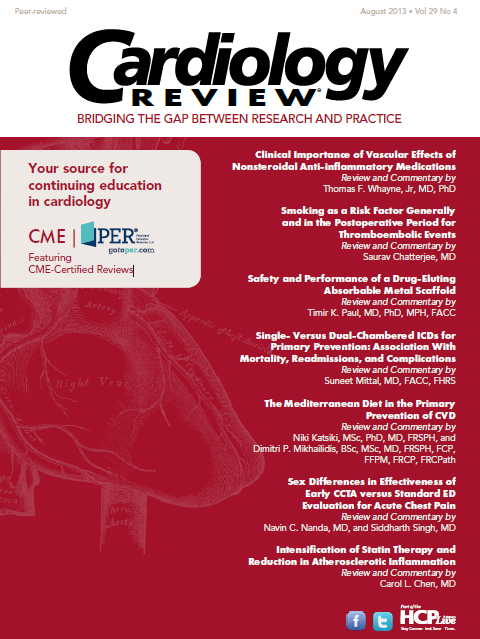Smoking as a Risk Factor Generally and in the Postoperative Period for Thromboembolic Events

Saurav Chatterjee, MD
Review

Study Details
The authors of a recent study published in Circulation1 set out to investigate the hypothesis that smoking is associated with venous thromboembolism (VTE) risk generally, and especially around the time of surgery. Data from the Million Women Study, a prospective cohort study that recruited 1.3 million women through the National Health Service (NHS) Breast Screening Program in England and Scotland, were used to examine the hypothesis.
The participants were women enrolled in the study between 1996 and 2001 via a recruitment questionnaire. Variables captured in the questionnaire were smoking status and amount currently smoked, height and weight, use of hormone replacement therapy, physical activity, alcohol consumption, medical and reproductive history, use of oral contraceptives, education, and other factors, as collected for study participants. Exclusion was based on women with a history of previous VTE, clotting disorder, cancer, surgery in the 12 weeks before recruitment, or loss to NHS follow-up before study entry. Also excluded were those with missing information on smoking.
Participant information allowed linkage to national registries, which captured information on hospital admission, including data on thromboembolic events. Women were classified as never, past, or current smokers as reported at recruitment; current smokers were further classified according to the average number (<15, ≥15) of cigarettes smoked per day. Women were determined to have undergone surgery during follow-up if the hospital data included 1 or more operative codes. Women were classified as having a VTE event if they had either a hospital admission record or death registration with an ICD code related to a VTE event.
During 6 years’ follow-up of 1,162,718 women (mean age, 56 years; body mass index, 26.1; 34% current users of hormone replacement therapy; 23.9% with hypertension; and 2.6% with diabetes), 4630 were admitted to the hospital for, or died from, VTE. Half of the cohort had never smoked (51%), whereas 28% were past smokers and 20% were current smokers at recruitment, with similar proportions smoking <15 and ≥15 cigarettes per day. The proportion of women in the lowest socioeconomic tertile increased from 27% in never-smokers to 51% in current heavy smokers. Smokers (past and current) were more likely to be current users of hormone replacement therapy than never-smokers, but current smokers were less likely to exercise regularly or to have a history of hypertension at recruitment.
In the absence of surgery, current smokers had a significantly increased incidence of VTE compared with never-smokers (adjusted relative risk [RR], 1.38; 95% confidence interval [CI], 1.28-1.48), with significantly greater risks in heavier than lighter smokers (RR, 1.47; 95% CI, 1.34-1.62; and RR, 1.29; 95% CI, 1.17-1.42 for ≥15 vs <15 cigarettes per day). Current smokers were also more likely to have surgery than never-smokers (RR, 1.12; 95% CI, 1.12-1.13). Among women who had surgery, the incidence of VTE in the first 12 postoperative weeks was significantly greater in current than neversmokers (RR, 1.16; 95% CI, 1.02-1.30), without evidence of significant heterogeneity in the results for <15 and ≥15 cigarettes per day, respectively (P-heterogeneity = 0.4). The investigators concluded that VTE incidence was increased in current smokers, both in the absence of surgery and in the 12 weeks after surgery. Furthermore, there was a trend that suggests greater risk with increasing number of cigarettes smoked per day. The implications for the study were that smoking is another factor to consider in the assessment of VTE risk in patients undergoing surgery.
Commentary Reinforcing the Role of Tobacco- Control Strategies in Women
The analysis presented suggests an increased risk of VTE related to smoking in middle-aged women. Prior studies have had conflicting results2,3 with respect to the issue of VTE risk in smokers. However, such evidence has come to light in the past for hard clinical events like stroke4,5; and myocardial infarctions.6 Thus, in light of this prior evidence and biological plausibility of the phenomenon, the current study extends the evidence to a higher risk of VTE in women who are smokers. The divergence between studies that find and do not find an association between smoking status and VTE has been, to some extent, attributed to differences in the distribution of light and heavy smokers in the study populations.
Smoking has been associated with both an increase in coagulation factors and impaired fibrinolysis, leading to increased risk of clot formation. Smoking is an established risk factor for chronic obstructive lung diseases. Diagnosing pulmonary embolism (PE) is challenging, in the presence of chronic obstructive lung disease, because perfusion/ventilation scans may be inconclusive in these patients. In addition, the most prominent symptom of PE — breathlessness — is normal for these patients. Dyspnea may be interpreted as a result of an exacerbation of the chronic obstructive lung disease, or as a result of pneumonia, which is prevalent among these patients. The effect of smoking on PE may therefore be underestimated due to information bias.
Detailed information on a range of potential confounding factors was available for this study. However, adjusting for these factors in the statistical analyses had only a minor impact on the estimated risk estimates. This indicates that residual confounding is unlikely to be the explanation for the observed associations. The FDA recommends that women over age 35 years who smoke should not take any type of combination birth control pill, due to an increased risk of serious thromboembolic events. The reported study provides further validation of the recommendation.
An equally intriguing and novel finding was the increased risk of VTE in smokers in the 12-week postoperative period. This finding, in a data set with much larger sample size and resultant power than previous reports, refutes prior analyses that suggest no increase in the risk of VTE events in smokers in the short-term postoperative period.7,8 In addition, the authors briefly mention, but do not adequately explore, a possible interplay/interaction between the use of oral contraceptives and smoking in the risk of VTE events.9 The relatively lower rates of VTE events in prior smokers do make a case for focusing public health efforts on the promotion of interventions for smoking cessation in women. This study also identifies smoking as a possible risk factor for postoperative VTE events, and points to the need for future research attempting to incorporate smoking as a component of pre-/perioperative risk scores for assessment of the likelihood of postoperative VTE events.10
References
1. Sweetland S, Parkin L, Balkwill A, Green J, Reeves G, Beral V; for the Million Women Study Collaborators. Smoking, surgery, and venous thromboembolism risk in women: United Kingdom cohort study. Circulation. 2013;127:1276-1282.
2. Cushman M, Kuller LH, Prentice R, et al; Women’s Health Initiative Investigators. Estrogen plus progestin and risk of venous thrombosis. JAMA. 2004;292:1573-1580.
3. Holst AG, Jensen G, Prescott E. Risk factors for venous thromboembolism: results from the Copenhagen City Heart Study. Circulation. 2010;121: 1896-1903.
4. Wolf PA, D’Agostino RB, Kannel WB, Bonita R, Belanger AJ. Cigarette smoking as a risk factor for stroke: the Framingham Study. JAMA. 1988;259:1025-1029.
5. Kawachi I, Colditz GA, Stampfer MJ, et al. Smoking cessation and decreased risk of stroke in women. JAMA. 1993;269:232-236.
6. Huxley RR, Woodward M. Cigarette smoking as a risk factor for coronary heart disease in women compared with men: a systematic review and meta-analysis of prospective cohort studies. Lancet. 2011;378:1297-1305.
7. Lowe GD, Haverkate F, Thompson SG, et al; on behalf of the ECAT DVT Study Group. Prediction of deep vein thrombosis after elective hip replacement surgery by preoperative clinical and haemostatic variables: the ECAT DVT Study. Thromb Haemost. 1999;81:879-886.
8. Fleming FJ, Kim MJ, Salloum RM, Young KC, Monson JR. How much do we need to worry about venous thromboembolism after hospital discharge? a study of colorectal surgery patients using the National Surgical Quality Improvement Program database. Dis Colon Rectum. 2010;53:1355-1360.
9. Pomp ER, Rosendaal FR, Doggen CJ. Smoking increases the risk of venous thrombosis and acts synergistically with oral contraceptive use. Am J Hematol. 2008;83:97-102.
10. Rogers SO Jr, Kilaru RK, Hosokawa P, Henderson WG, Zinner MJ, Khuri SF. Multivariable predictors of postoperative venous thromboembolic events after general and vascular surgery: results from the patient safety in surgery study. J Am Coll Surg. 2007;204:1211-1221.
About the Author
Saurav Chatterjee, MD, is Clinical and Research Fellow in Cardiology at the St Luke’s-Roosevelt Hospital of the Columbia University of Physicians and Surgeons. He graduated from Calcutta National Medical College with honors and was a Resident in cardiology in Mercy Hospital, Kolkata, India, as well as trial coordinator of the CRESCENDO trial in Kolkata, India. He recently completed his residency in Internal Medicine from Maimonides Medical Center in Brooklyn, NY, and was Clinical and Research Fellow in Preventive Cardiology and Outcomes Research at Brown University and Providence VAMC in Providence, RI. Dr. Chatterjee is the recipient of the 2012 Young Investigator Award for Health Outcomes and Population Genetics at the Annual Scientific Sessions of the American College of Cardiology 2012 in Chicago, and also the 2011 American Association of Cardiologists of Indian Origin (AACIO) Young Investigator Award for Interventional Cardiology and Electrophysiology.
Sweetland S, Parkin L, Balkwill A, Green J, Reeves G, Beral V; for the Million Women Study Collaborators. Smoking, surgery, and venous thromboembolism risk in women: United Kingdom cohort study. Circulation. 2013;127:1276-1282.
